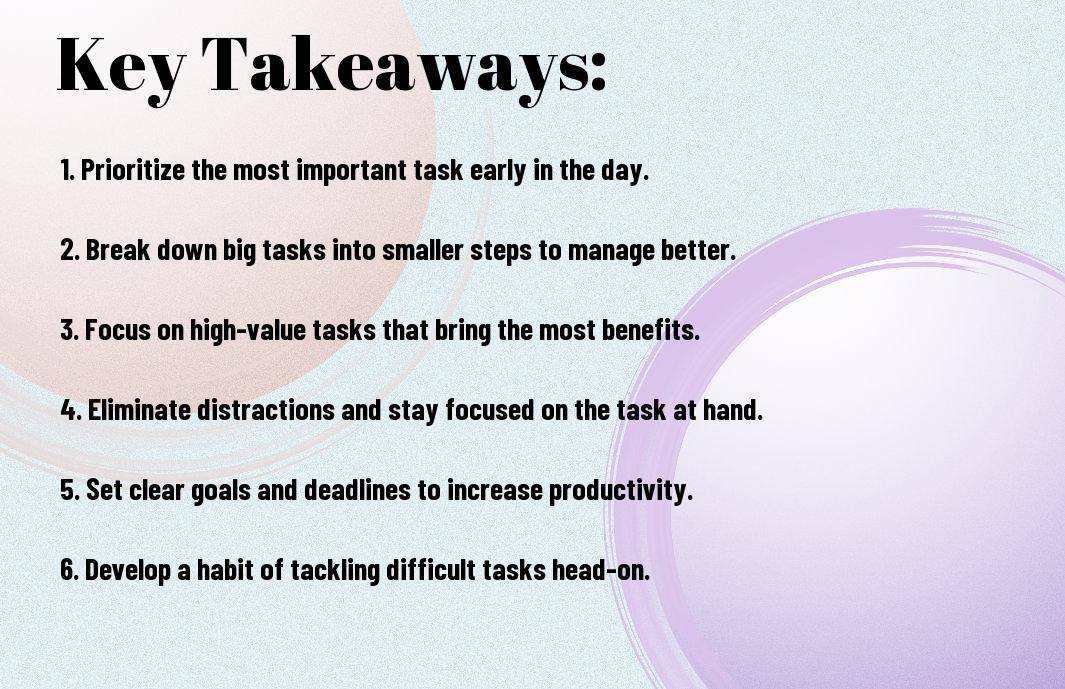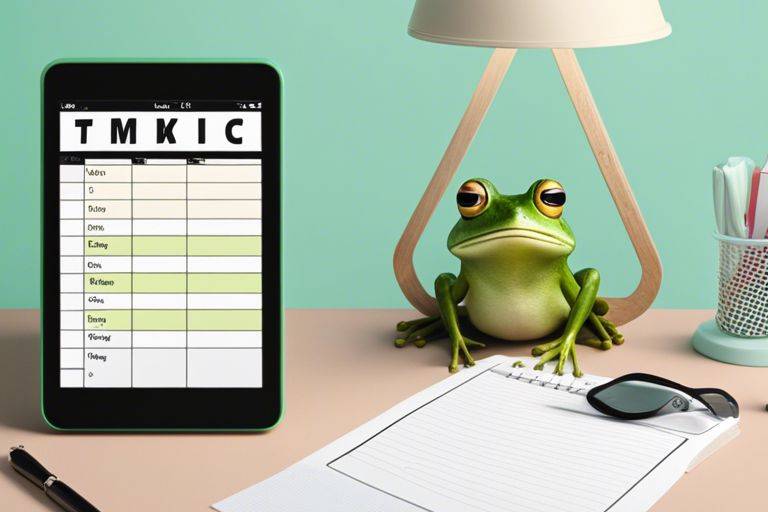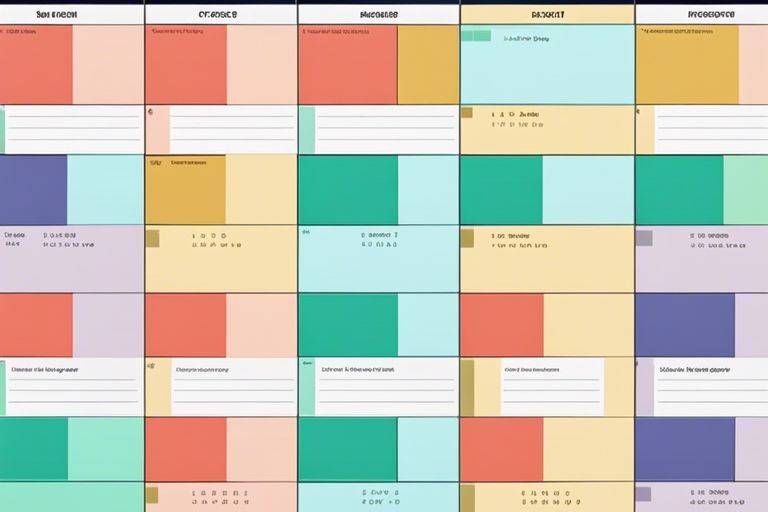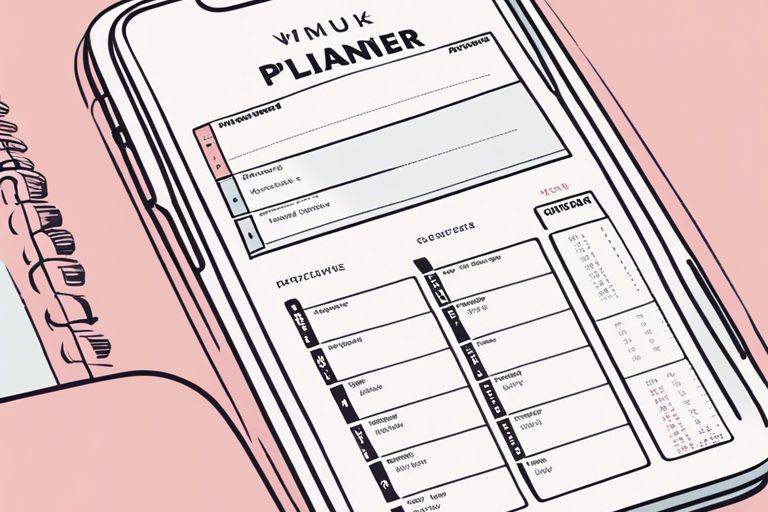Overwhelmed by a lengthy to-do list? Brian Tracy’s Eat That Frog method advocates tackling the most challenging task first to boost productivity and efficiency. Focusing on prioritizing tasks based on importance rather than urgency, this approach emphasizes the benefits of conquering the most daunting task right at the beginning of the day.
Key Takeaways:
- Identify the most challenging task: Prioritize the task that will have the most significant impact once completed.
- Take immediate action: Start working on the task right away to avoid procrastination.
- Break the task down: Divide the challenging task into smaller, more manageable parts to tackle it effectively.
- Set clear goals: Define specific and achievable objectives to track progress and stay motivated.
- Create a plan: Develop a step-by-step plan to systematically work towards completing the task.
- Eliminate distractions: Focus on the task at hand by removing distractions and creating a conducive work environment.
- Celebrate achievements: Acknowledge your accomplishments along the way to stay motivated and maintain momentum.

Understanding Procrastination
There’s a common enemy that plagues productivity and success – procrastination. It’s the act of delaying or postponing tasks, often to the point of causing stress and anxiety. Procrastination can hinder progress and prevent individuals from reaching their full potential.
The Psychology Behind Procrastination
The psychology behind procrastination is complex but often boils down to a fear of failure or perfectionism. Many individuals procrastinate because they are afraid of not meeting expectations or making mistakes. They may also have a deep desire for their work to be flawless, which can lead to putting off tasks until the last minute.
Identifying Your Personal Procrastination Patterns
To identify your personal procrastination patterns, it’s crucial to reflect on your behavior and habits when faced with tasks. Do you find yourself procrastinating when the task seems overwhelming? Or do you delay starting until you feel the pressure of a deadline? Understanding why you procrastinate can help you develop strategies to overcome this habit.
With self-awareness and reflection, you can pinpoint the specific triggers that lead you to procrastinate. Whether it’s a fear of failure, perfectionism, or simply feeling unmotivated, recognizing these patterns is the first step towards overcoming procrastination and boosting productivity.
The ‘Eat That Frog’ Method
Origin of the ‘Eat That Frog’ Metaphor
Not every day you hear advice that tells you to eat a frog, but in productivity and time management, that’s exactly what one should do. The ‘Eat That Frog’ methodology popularized by productivity guru Brian Tracy is centered around tackling your most challenging task first thing in the morning, which is often metaphorically referred to as ‘eating the frog’.
Core Philosophy
Metaphorically speaking, the ‘frog’ represents the most difficult or undesirable task on your to-do list. By eating that frog first thing in the morning, you are starting your day by accomplishing the most important task, setting the tone for a productive day ahead. This approach is based on the idea that if you tackle the most challenging task when your energy and focus are at their peak, you will feel a sense of accomplishment and momentum that carries through to the rest of your day.
Core: The core philosophy of the ‘Eat That Frog’ method is to prioritize your tasks based on their importance and tackle the most daunting one right away. This not only helps in increasing productivity but also builds a habit of taking on challenging tasks head-on, leading to personal growth and development.
Setting Clear Goals
After outlining the importance of prioritizing tasks effectively, the next step in the ‘Eat That Frog’ methodology is setting clear goals. Without well-defined goals, it’s challenging to measure progress and stay focused on what truly matters.
The Role of Goal Setting in Productivity
To achieve maximum productivity, it is crucial to set specific, measurable, achievable, relevant, and time-bound (SMART) goals. Clear goals provide a roadmap for success, helping individuals stay organized and motivated throughout their tasks. By establishing clear objectives, individuals can break down complex projects into manageable chunks and track their progress effectively. This not only enhances productivity but also boosts confidence and overall performance.
Techniques for Effective Goal Setting
Productivity experts recommend several techniques for effective goal setting. One of the most popular methods is the ‘Ivy Lee Method,’ which suggests prioritizing your goals by writing down the six most important tasks for the next day. This technique helps individuals focus on key priorities and minimizes distractions. Another technique is the ‘Pareto Principle,’ also known as the 80/20 rule, which emphasizes focusing on the 20% of tasks that yield 80% of the results. By identifying and prioritizing these high-impact tasks, individuals can maximize their productivity and efficiency.
Setting clear and achievable goals is the foundation of effective time management and productivity. By defining specific objectives and breaking them down into manageable steps, individuals can enhance their focus, motivation, and performance.

The Art of Prioritizing Tasks
All successful individuals have one thing in common – they prioritize their tasks effectively. The ability to identify and tackle the most important tasks first is a skill that can greatly impact your productivity and success. In this chapter, we will explore into the art of prioritizing tasks and explore techniques to help you conquer your to-do list with ease.
The ABCDE Method Explained
One popular method for prioritizing tasks is the ABCDE method, which was popularized by productivity expert Brian Tracy. With this method, you assign a letter to each task based on its importance and urgency. Tasks marked as A are the most important and must be completed as soon as possible, while tasks marked as E are the least important and can be eliminated altogether.
Tips to Prioritize Effectively
Any effective prioritization strategy involves assessing your tasks based on their significance and deadline. To prioritize effectively, start by listing down all your tasks and categorizing them based on importance and urgency. Focus on completing tasks that fall under the A category first, followed by those in the B category. Assume that by tackling your most critical tasks first, you’ll make significant progress towards your goals.
- Identify tasks that are crucial to your success
- Set clear deadlines for each task
- Allocate your time and resources wisely
This chapter emphasizes the importance of prioritizing tasks effectively to maximize your productivity and achieve your goals. By implementing the ABCDE method and following the tips outlined here, you can take control of your to-do list and make significant strides towards your success. Note, the key to success lies in your ability to prioritize wisely.

Overcoming Procrastination
Despite our best intentions, procrastination can sneak up on us and derail our productivity. It is the enemy of progress and success, holding us back from achieving our goals and potential. However, with the right strategies and mindset, we can overcome procrastination and take control of our time and tasks.
Strategies to Defeat Procrastination
For many people, the key to defeating procrastination lies in breaking tasks down into smaller, more manageable chunks. By breaking a large and daunting task into smaller, more achievable steps, we can avoid feeling overwhelmed and make progress incrementally. Additionally, utilizing tools such as time management apps and setting clear deadlines can help create a sense of urgency and accountability, making it harder to put tasks off.
Developing a Proactive Mindset
For individuals looking to develop a proactive mindset and overcome procrastination, it is vital to focus on prioritizing tasks effectively and eliminating distractions. By identifying the most critical tasks and tackling them first, we can ensure that progress is made on the most important priorities. Additionally, cultivating a positive mindset and seeking support from peers or mentors can help keep us motivated and on track towards our goals.
The process of developing a proactive mindset involves making a conscious effort to stay focused on tasks at hand and resist the temptation to procrastinate. By understanding the consequences of procrastination and the benefits of staying proactive, individuals can train themselves to be more disciplined and efficient in their work.

Time Management Skills
To effectively manage your time, it is imperative to prioritize tasks and focus on completing the most important and challenging ones first. This approach not only increases productivity but also reduces stress and helps you achieve your goals more efficiently. Brian Tracy’s ‘Eat That Frog’ philosophy emphasizes the significance of time management in enhancing personal and professional success.
The Importance of Time Management
Management of time is crucial for individuals seeking to make the most out of their lives. By prioritizing tasks based on their significance and deadlines, one can ensure that they are investing their time and energy into activities that align with their goals and values. Effective time management enables individuals to work smarter, not harder, leading to increased efficiency and effectiveness in all areas of life.
Tools and Techniques to Manage Time Efficiently
Any successful time management strategy involves utilizing various tools and techniques to enhance productivity. These may include creating to-do lists, using time tracking apps, setting realistic deadlines, practicing the 2-minute rule, and implementing the Pomodoro technique. By leveraging these tools, individuals can better organize their tasks, minimize distractions, and optimize their time to accomplish more in less time.
Time is a limited and non-renewable resource, making it imperative to manage it effectively. Procrastination, lack of planning, and poor time management skills can hinder personal and professional growth. By adopting efficient time management techniques, individuals can take control of their schedules, improve their focus and productivity, and ultimately achieve success in their endeavors.
Building Consistency and Maintaining Momentum
Unlike popular belief, achieving productivity and conquering challenging tasks isn’t just about one-time efforts. It’s about building consistency in your approach and maintaining momentum over time. Brian Tracy’s “Eat That Frog” philosophy emphasizes the importance of creating habits that support your productivity goals.
The Power of Habit in Productivity
Any successful individual will attest to the power of habit in boosting productivity. By establishing a routine that prioritizes the most important tasks and tackling them first, you train your mind to focus on what truly matters. Consistency in this approach builds momentum and reinforces the habit of taking on challenging tasks without procrastination.
Staying Motivated and Overcoming Slumps
Staying motivated is crucial in the journey towards increased productivity. Motivation can wane, leading to slumps that hinder progress. By recognizing the signs of a slump and implementing strategies to overcome it, you can stay on track towards your goals. Consistency in staying motivated, even during tough times, is key to maintaining momentum and achieving success.
Motivated individuals are not immune to challenges or fluctuations in their drive. It’s imperative to develop coping mechanisms and strategies to reignite your motivation when faced with obstacles. By identifying what fuels your passion and creating a support system to keep you accountable, you can push through slumps and continue making progress towards your goals.
Applying ‘Eat That Frog’ in Daily Life
Many individuals struggle with procrastination and find it challenging to prioritize tasks effectively. Brian Tracy’s ‘Eat That Frog’ approach offers a solution to this common problem by advocating for tackling the most difficult task first. By applying this strategy in daily life, individuals can enhance their productivity and achieve greater success in their personal and professional endeavors.
Personal Development and Continuous Improvement
One way to apply the ‘Eat That Frog’ technique in daily life is by incorporating it into personal development efforts. By addressing the most challenging task at the beginning of the day, individuals can develop a sense of accomplishment and motivation that propels them to tackle other tasks with more confidence and efficiency. Consistently practicing this approach can lead to continuous improvement in one’s productivity and time management skills.
Leveraging the Technique in Various Aspects of Life
Personal growth and development are vital components of leveraging the ‘Eat That Frog’ technique in various aspects of life. By prioritizing tasks based on their importance and tackling the most difficult ones first, individuals can experience a sense of empowerment and control over their daily responsibilities. This approach can be applied not only in professional settings but also in personal projects, relationships, and self-care routines.
This strategy is particularly effective for individuals who are looking to overcome procrastination and achieve their goals more efficiently. By breaking down tasks into smaller, manageable steps and starting with the most challenging ones, individuals can build momentum and maintain a positive trajectory throughout the day. Embracing the ‘Eat That Frog’ philosophy can lead to increased productivity, reduced stress, and a greater sense of accomplishment in all areas of life.
To wrap up
Conclusively, Brian Tracy’s approach of tackling the most challenging task first, as outlined in his book “Eat That Frog,” proves to be an effective time management technique. By focusing on the most difficult tasks early in the day, individuals can increase productivity, reduce procrastination, and build
FAQ
momentum for the rest of the day. This method helps individuals prioritize effectively, stay organized, and achieve their goals efficiently. To learn more about how this productivity system can benefit you, check out We tried it: Eat That Frog (productivity system).
Q: What is the importance of ‘Eat That Frog’ by Brian Tracy?
A: ‘Eat That Frog’ by Brian Tracy emphasizes the importance of tackling the most challenging task first to increase productivity and achieve success.
Q: What does the term ‘Eat That Frog’ mean?
A: The term ‘Eat That Frog’ is a metaphor for tackling your biggest, most important task first thing in the morning, before you do anything else.
Q: How does prioritizing tasks help in productivity?
A: Prioritizing tasks helps in productivity by allowing you to focus on high-value activities that have the most significant impact on your goals.
Q: What are the benefits of following Brian Tracy’s approach to task management?
A: Following Brian Tracy’s approach helps you overcome procrastination, increase efficiency, reduce stress, and achieve your goals effectively.
Q: How can one apply the ‘Eat That Frog’ principle in daily life?
A: To apply the ‘Eat That Frog’ principle, identify your most challenging task, break it into smaller steps, and commit to completing it before moving on to other tasks.
Q: What are some practical tips for effective task management according to Brian Tracy?
A: Some practical tips for effective task management include setting clear goals, prioritizing tasks, focusing on high-value activities, and avoiding distractions.
Q: How can ‘Eat That Frog’ help in personal and professional growth?
A: ‘Eat That Frog’ can help in personal and professional growth by improving time management skills, increasing productivity, and fostering a sense of accomplishment and success.
Expand your reading
- The 2 Minute Rule – David Allen’s (popularized) Trick to Overcome Procrastination and Start Tasks
- SMART Goals – George T. Doran’s Method for Setting Clear and Achievable Goals
- Night Before Planning – Preparing for Next-Day Productivity the Night Before
- The Zeigarnik Effect – Bluma Zeigarnik’s Use of Open Tasks to Boost Motivation
- Pomodoro Technique – Francesco Cirillo’s Method to Improve Focus and Manage Time



